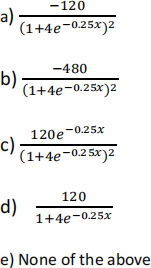Math 1231(Calculus for Business and Economics) Spring 2023 FINAL EXAM
Hello, dear friend, you can consult us at any time if you have any questions, add WeChat: daixieit
DEPARTMENT OF MATHEMATICS
FINAL EXAM
Math 1231
(Calculus for Business and Economics)
Spring 2023
1. (6 points) Let f(x) = 16x2 − 1 + 4x. Use the limit definition of the derivative to find f′(x). Show all steps, especially the algebra involved, and use proper notation.
2. (4 points) Evaluate the following integral using method of u-substitution.

3. (3 points each) For all parts of this question, circle the correct answer. (No partial credit will be given for incorrect answers).
(i) Find the derivative of F(x) = ln(x)3x

(ii) Find the derivative of 

(iii) Find the derivative of 

(iv) Find the general anti-derivative of 

(v) Find the anti-derivative of 

4. (3 points each) Business A has modeled their profits in thousands of dollars by the function:
p(x) = −0.124x2 + 3x
where x is the time in days.
a) Evaluate the following integral:

b) Write a sentence interpreting the meaning of the result from the previous integral.
5. (8 points) Suppose f is a function whose derivative is given by f′(x) = 3x3 − 48x.
Use algebra to find the x-coordinate(s) of all critical points of the function. Use the first derivative test to determine which of the critical points are local(relative) maximum points, which are local(relative) minimum points, and which are neither (if any). Show all work/justifications clearly.
6. (5 points) Calculate the derivative of the function

Show all the steps and use proper notation. Do not simplify your answer.
7. (10 points) The demand for fashion sunglasses can be modelled by:
D(x) = −x3 + 9x2 − 30x + 200
where x is the selling price in hundreds of dollars and 0 ≤ x ≤ 5.
a) Find a simplified formula for R(x), the revenue generated from selling the sunglasses at x hundred dollars.
b) Find the revenue when the selling price is $300.
c) Find the rate of change of revenue when the selling price is $300. Give units.
d) Using your answers from parts b) and c), estimate the revenue if the selling price is set to be $350.
8. (5 points) ) Let F(x) be a specific antiderivative of 3x4 − 4x + 1, and F(−1) = 15, find F(x). Show all work and do not round off.
F(x) =
9. The table below gives the maintenance costs for vehicles driven for 15000 miles in the United States from 1993 through 2000. The maintenance costs given are yearly averages.

(a) (4 points) Let C(x) denote the costs for the vehicles driven for 15000 miles where x is the number of years since 1993. Use the table above to find a best fit model for C(x). Give the model rounding each coefficient to 3 decimal places.
(b) (3 points) Using the full model, calculate percentage change in maintenance cost from 1999 to 2002. Use two decimal places and give units.
(c) (3 points) According to the full model how rapidly were maintenance costs increasing in 1998? Show your work. Give your answer to 2 decimal places.
10. (12 points) A company produces bracelets for a fundraiser. The profit, in dollars, from selling bracelets is given by the function
P(x) = (x − 10)(500 − x ln(3x))
when the selling price of each bracelet is x dollars. Carefully enter the function P(x) into Y1 on your calculator. Check that you’ve entered the function correctly by computing P(15).
You should obtain 2214.5003132673.
Based on past experience with fundraisers, the company expects the selling price of a bracelet to be between $20 and $80.
a) Sketch the graph P′(x), 20 ≤ x ≤ 80 and indicate the critical point of P(x) on this graph by “CP”
b) Using appropriate calculator procedures, find the selling price, x, that maximizes P(x).
Briefly write down the steps from the calculator procedure you used. Round your answer to four decimal places. Give units.
c) Use the second derivative test to show that the price you found in part b) indeed yields a maximum profit.
11. Consider the function  where 5 ≤ t ≤ 15. Carefully enter the function D(t) into Y1 on your calculator. Check that you’ve entered the function correctly by computing D(5). You should obtain 1.1794871794872.
where 5 ≤ t ≤ 15. Carefully enter the function D(t) into Y1 on your calculator. Check that you’ve entered the function correctly by computing D(5). You should obtain 1.1794871794872.
a. (4 points) Find the inflection point of D(t) in the interval 5 ≤ t ≤ 15. Give your answer with five decimal places. Briefly write down the steps from the calculator procedure you used.
b. (2 points) Circle the equation that you solved:
i. D′ (t) = 0 (ii)D′′(t) = 0. (iii)D′ (t) = D′′(t)
c. (5 points) Graph the function D(t) over 0 ≤ t ≤ 15. Indicate on the graph the point corresponding to your answer in (a).
tmin = 5 tmax = 15 ymin = ____ ymax = ____

12. (8 points) Make a sketch of the region whose area is given by the definite integral  Draw 4 left rectangles to estimate the value of the definite integral. Show your work and round your final answer to four decimal places.
Draw 4 left rectangles to estimate the value of the definite integral. Show your work and round your final answer to four decimal places.
2023-12-14